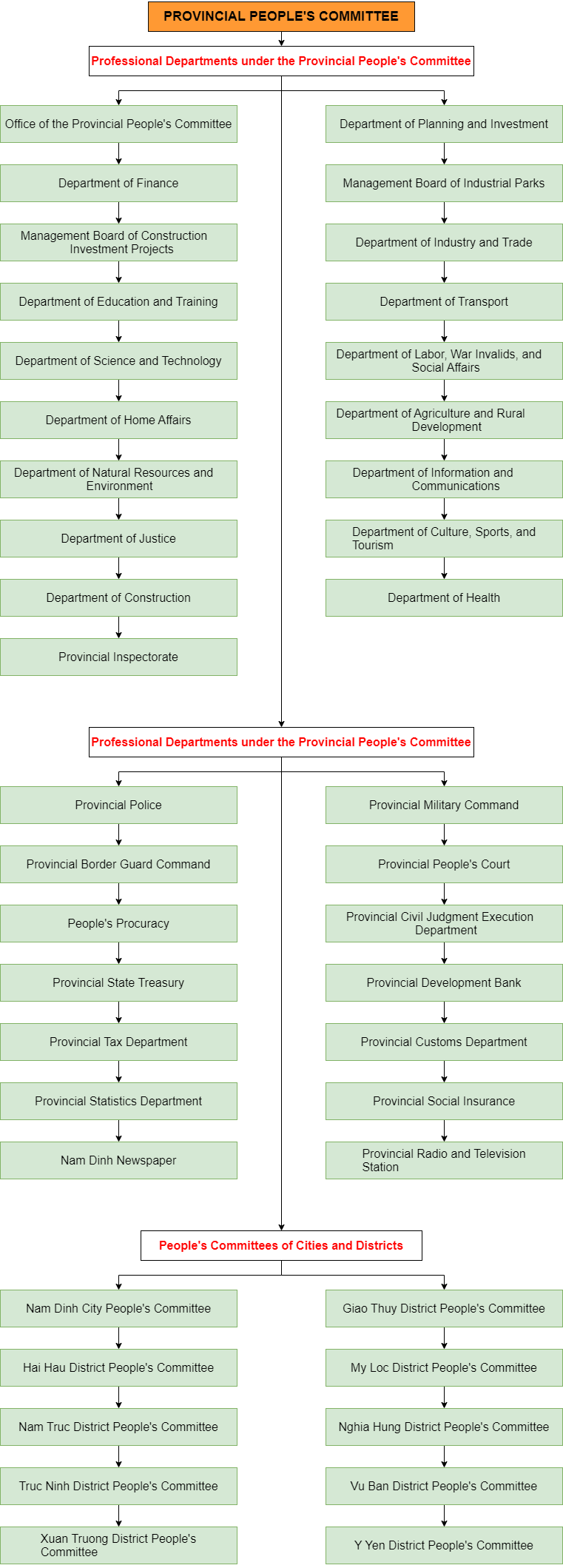Nam Dinh’s Organizational Structure Diagram
Nam Dinh’s Organizational Structure Diagram
I. Address/ Contact
Nam Dinh Provincial People's Committee
Address: 57 Vi Hoang Street, Nam Dinh City, Nam Dinh Province
Phone: (0228) 3849315
Fax: (0228) 3867059
II. Structure

III. FUNCTIONS AND DUTIES
People's Committee:
According to Clause 1, Article 8 of the Law on Organization of Local Government dated June 19, 2015, the regulations are as follows:
The People's Committee is elected by the People's Council at the same level, serving as the executive body of the People's Council and the state administrative agency in the locality. It is responsible to the local people, the People's Council of the same level, and the higher-level state administrative agencies.
The People's Committee consists of the Chairman, Vice Chairmen, and members. The specific number of Vice Chairmen at each administrative level is determined by the Government.
Specialized Agencies under the People's Committee:
According to Article 9 of the Law on Organization of Local Government dated June 19, 2015, the regulations are as follows:
Specialized agencies under the People's Committee are organized at the provincial and district levels. These agencies serve as advisory bodies to assist the People's Committee in performing state management functions in specific sectors and fields within the locality and in carrying out duties and powers delegated or authorized by higher-level state agencies.
Specialized agencies under the People's Committee are directed and managed regarding their organization, staffing, and operations by the People's Committee. Simultaneously, they are subject to professional direction and supervision from higher-level state management agencies in the respective sectors and fields.
The organization of specialized agencies under the People's Committee must:
- Align with the characteristics of rural, urban, island areas, and the economic-social development conditions and situations of each locality.
- Ensure streamlined, logical, and effective state management from the central to the grassroots level.
- Avoid overlapping with the duties and powers of higher-level state agencies based in the locality.
The Government specifically regulates the organization and operation of specialized agencies under the provincial and district People's Committees.
IV. PRINCIPLES OF ORGANIZATION AND OPERATION
The principles of organization and operation of the People's Committee are stipulated in Article 5 of the Law on the Organization of Local Government, dated June 19, 2015:
- Compliance with the Constitution and Law
Govern society by law; implement the principle of democratic centralism.
- Modernity, Transparency, Service to the People
Operate transparently, serve the People, and be subject to their oversight.
- Operational Structure
The People's Committee operates under a collective system combined with the responsibilities of the Chairman of the People's Committee.
Tasks and Powers of the Provincial People's Committee
As outlined in Article 21 of the Law on the Organization of Local Government, dated June 19, 2015:
- Policy Development and Implementation
Develop and submit for approval to the Provincial People's Council the contents specified in Points a, b, and c of Clause 1; Points d, đ, and e of Clause 2; and Clauses 3, 4, 5, 6, and 7 of Article 19 of the Law on the Organization of Local Government. Implement the resolutions of the Provincial People's Council.
- Administrative Organization
Define the organizational structure and specific tasks and powers of specialized agencies under the Provincial People's Committee.
- Economic and Social Development
Execute the provincial budget and tasks related to socio-economic development, including industries such as industrial development, construction, commerce, services, tourism, agriculture, forestry, fisheries, transportation networks, irrigation systems, and land use management. Manage forests, rivers, lakes, water resources, minerals, marine resources, airspace, and other natural resources; implement disaster prevention and environmental protection measures within the province’s jurisdiction.
- Programs and Projects for Minority and Underprivileged Regions
Develop and execute programs, projects, and initiatives targeting ethnic minority groups and areas with particularly challenging socio-economic conditions.
- Defense and Security
Implement measures to build an all-people national defense posture in coordination with a people's security posture within the province. Direct plans for establishing a strong defense zone, organize national defense and security education, conduct local military activities, and support operations of local military forces and self-defense militia. Build reserve forces and mobilize them as required by law; foster public movements to protect national security at the local level.
- Governance and Public Services
Fulfill tasks related to ensuring the enforcement of the Constitution and laws, building local government and administrative boundaries, and managing fields such as education, training, science, technology, culture, information, sports, healthcare, labor, social policies, ethnic affairs, religion, national defense, security, social order, public safety, judicial administration, legal assistance, and other duties as prescribed by law.
- Decentralization and Delegation of Authority
Carry out tasks and powers delegated or authorized by central government agencies.
- Subordinate Delegation
Delegate tasks and powers to lower-level People's Committees, agencies, and other organizations for the execution of provincial People's Committee responsibilities.